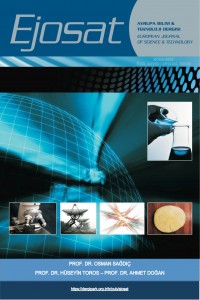Öz
The Internet of Things (IoT) and the 5G app need many services to be real, as they have very limited processing and storage resources, and their cloud computing connection is a relevant factor and great interest for researchers from all over the world. Latency, big data, storage, and power processing problems near high-end devices led to the appearance of fog computing. Fog computing is the interconnection between IoT devices and cloud computing and can bring processing and storage capacity to IoT devices, making it possible for new technologies and applications to address these flaws today. This paper introduces the concept of fog computing, its challenges, theoretical context, implementation and implementation of fog computing, and the application of a genetic algorithm for the distribution of resources for IoT devices using integrated systems platforms and comparing their results with those obtained by a high-performance server. The Fog-Sys system was developed with the main objective of simulating, receiving, verifying, and storing data from IoT devices to be transferred to the cloud computing, and it works like a fog computing to provide the storage as a service (StaaS) service. Also using a fuzzy genetic algorithm (FGA) to try to reduce the energy consumed. The results showed that implementing this service in the built-in system devices can be a good alternative to reduce one of these problems, in this case, storing data and reducing the energy consumed, which today affects IoT devices.
Anahtar Kelimeler
Fog computing Cloud computing Fuzzy logic Fuzzy genetic algorithm StaaS IoT
Kaynakça
- S. Zhao, X. Du, i S. Li, „OPTIMIZATION OF RESOURCE ALLOCATION IN CONSTRUCTION USING GENETIC ALGORITHMS“, izd. August, str. 18–21, 2005.
- M. J. Varnamkhasti, L. S. Lee, M. Rizam, A. Bakar, i W. J. Leong, „A Genetic Algorithm with Fuzzy Crossover Operator and Probability“, sv. 2012, str. 1–17, 2012.
- H. Gupta, S. Chakraborty, i S. K. Ghosh, „Fog Computing in 5G Networks : An Application Perspective“, str. 1–36, 2016.
- S. Kitanov i T. Janevski, „Energy Efficiency of Fog Computing and Networking Services in 5G Networks“, izd. July 2017, str. 6–8, 2020. C. X. Mavromoustakis, A. Bourdena, G. Mastorakis, i E. Pallis, „An energy-aware scheme for efficient spectrum utilization in a 5G mobile cognitive radio network architecture“, 2014.
- B. Krause, C. Von Altsock, B. Krause, i M. Pozybill, „Fuzzy Logic Data Analysis of Environmental Data for Traffic Control“, str. 835–838.
- M. A. Benblidia, B. Brik, L. Merghem-boulahia, i M. Esseghir, „Ranking Fog nodes for Tasks Scheduling in Fog-Cloud Environments : A Fuzzy Logic Approach“, 2019 15th Int. Wirel. Commun. Mob. Comput. Conf., str. 1451–1457, 2019.
Öz
The Internet of Things (IoT) and the 5G app need many services to be real, as they have very limited processing and storage resources, and their cloud computing connection is a relevant factor and great interest for researchers from all over the world. Latency, big data, storage, and power processing problems near high-end devices led to the appearance of fog computing. Fog computing is the interconnection between IoT devices and cloud computing and can bring processing and storage capacity to IoT devices, making it possible for new technologies and applications to address these flaws today. This paper introduces the concept of fog computing, its challenges, theoretical context, implementation and implementation of fog computing, and the application of a genetic algorithm for the distribution of resources for IoT devices using integrated systems platforms and comparing their results with those obtained by a high-performance server. The Fog-Sys system was developed with the main objective of simulating, receiving, verifying, and storing data from IoT devices to be transferred to the cloud computing, and it works like a fog computing to provide the storage as a service (StaaS) service. Also using a fuzzy genetic algorithm (FGA) to try to reduce the energy consumed. The results showed that implementing this service in the built-in system devices can be a good alternative to reduce one of these problems, in this case, storing data and reducing the energy consumed, which today affects IoT devices.
Anahtar Kelimeler
Fog computing Cloud computing Fuzzy logic Fuzzy genetic algorithm StaaS IoT
Kaynakça
- S. Zhao, X. Du, i S. Li, „OPTIMIZATION OF RESOURCE ALLOCATION IN CONSTRUCTION USING GENETIC ALGORITHMS“, izd. August, str. 18–21, 2005.
- M. J. Varnamkhasti, L. S. Lee, M. Rizam, A. Bakar, i W. J. Leong, „A Genetic Algorithm with Fuzzy Crossover Operator and Probability“, sv. 2012, str. 1–17, 2012.
- H. Gupta, S. Chakraborty, i S. K. Ghosh, „Fog Computing in 5G Networks : An Application Perspective“, str. 1–36, 2016.
- S. Kitanov i T. Janevski, „Energy Efficiency of Fog Computing and Networking Services in 5G Networks“, izd. July 2017, str. 6–8, 2020. C. X. Mavromoustakis, A. Bourdena, G. Mastorakis, i E. Pallis, „An energy-aware scheme for efficient spectrum utilization in a 5G mobile cognitive radio network architecture“, 2014.
- B. Krause, C. Von Altsock, B. Krause, i M. Pozybill, „Fuzzy Logic Data Analysis of Environmental Data for Traffic Control“, str. 835–838.
- M. A. Benblidia, B. Brik, L. Merghem-boulahia, i M. Esseghir, „Ranking Fog nodes for Tasks Scheduling in Fog-Cloud Environments : A Fuzzy Logic Approach“, 2019 15th Int. Wirel. Commun. Mob. Comput. Conf., str. 1451–1457, 2019.
Ayrıntılar
| Birincil Dil | İngilizce |
|---|---|
| Konular | Mühendislik |
| Bölüm | Makaleler |
| Yazarlar | |
| Yayımlanma Tarihi | 15 Ağustos 2020 |
| Yayımlandığı Sayı | Yıl 2020 Ejosat Özel Sayı 2020 (HORA) |


